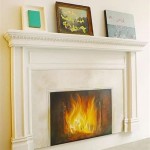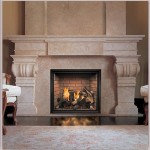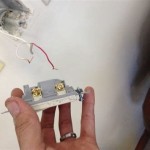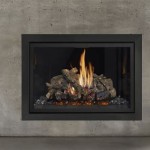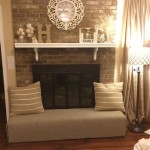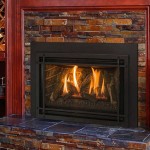Modern Brick Fireplace: A Timeless Element Reimagined
The fireplace, historically a focal point for warmth and social gathering, has undergone a significant evolution in design and functionality. While traditionally associated with rustic charm, the modern brick fireplace represents a striking blend of classic material and contemporary aesthetics. This article explores the key characteristics, design considerations, and installation intricacies of the modern brick fireplace, highlighting how this enduring element can transform residential spaces.
The enduring appeal of brick lies in its inherent durability, warmth, and textural richness. In the context of modern design, brick provides a tactile and visually engaging counterpoint to sleek surfaces and minimalist forms. The modern brick fireplace is not simply a source of heat; it's a carefully considered architectural feature that contributes significantly to the overall ambiance and style of a room.
Key Characteristics of the Modern Brick Fireplace
Modern brick fireplaces differ significantly from their traditional counterparts in several key aspects. These differences manifest in design, construction, and the overall integration with the surrounding environment.
First, the aesthetic is typically characterized by clean lines and a minimalist approach. Elaborate ornamentation and intricate detailing are generally absent, replaced by simple geometric forms and a focus on the natural beauty of the brick itself. This simplicity allows the fireplace to seamlessly integrate with a variety of contemporary interior styles, from mid-century modern to industrial chic.
Second, the firebox itself has often been reimagined. While traditional fireplaces relied primarily on open hearths, modern designs frequently incorporate enclosed fireboxes with glass doors. This provides increased energy efficiency, improved safety, and greater control over the burning process. Furthermore, these enclosed fireboxes often feature sleek, linear designs that complement the overall aesthetic of the fireplace.
Third, the surrounding brickwork is often treated in unexpected ways. Rather than simply creating a traditional chimney breast, designers may opt for floating shelves, integrated storage, or other architectural elements that incorporate the brick in a more dynamic and functional manner. The color and texture of the brick can also be carefully selected to create a specific mood or visual effect. For example, a light-colored brick can brighten a space and create a sense of airiness, while a dark-colored brick can add depth and drama.
Finally, advancements in fireplace technology have also influenced the modern brick fireplace. Gas fireplaces, electric fireplaces, and even bioethanol fireplaces can be incorporated into brick surrounds, offering alternatives to traditional wood-burning options. These alternatives provide greater convenience, reduced maintenance, and improved environmental performance.
Design Considerations for Modern Brick Fireplaces
Designing a modern brick fireplace requires careful consideration of several factors, including the overall style of the room, the size and location of the fireplace, and the type of fuel source that will be used. A well-designed fireplace will not only provide warmth and visual appeal but also seamlessly integrate with the surrounding architecture and enhance the overall functionality of the space.
The first consideration is the overall style of the room. The fireplace should complement the existing aesthetic, whether it's minimalist, Scandinavian, industrial, or something else entirely. The color, texture, and pattern of the brick should be chosen to harmonize with the surrounding furnishings and décor. For example, a sleek, modern room with minimalist furniture might benefit from a fireplace with smooth, light-colored brick and clean lines. Conversely, an industrial-style loft with exposed beams and concrete floors might be better suited to a fireplace with rough, dark-colored brick and a more rugged aesthetic.
The size and location of the fireplace are also crucial considerations. A fireplace that is too large or too small for the room will look out of proportion and detract from the overall design. The location of the fireplace should be carefully chosen to maximize its impact and functionality. A fireplace placed in the center of a wall can create a strong focal point, while a fireplace placed in a corner can help to define a seating area. The distance between the fireplace and furniture should also be considered to ensure comfortable viewing and prevent overheating.
The choice of fuel source is another important consideration. Wood-burning fireplaces offer a traditional ambiance and the authentic crackling sound of burning wood. However, they also require more maintenance and can be less energy-efficient. Gas fireplaces offer greater convenience and control over the burning process, while electric fireplaces offer a completely clean and vent-free option. The choice of fuel source will depend on individual preferences, budget, and environmental concerns.
Furthermore, consider the architectural details surrounding the fireplace. Incorporating elements like built-in shelving, mantels, or artwork can enhance the fireplace's visual appeal and create a cohesive design. The use of contrasting materials, such as wood, metal, or glass, can also add visual interest and create a more dynamic composition.
Finally, lighting plays a critical role in enhancing the ambiance of a modern brick fireplace. Consider incorporating recessed lighting, sconces, or pendant lights to illuminate the brickwork and create a warm and inviting atmosphere. Adjustable lighting allows for varying the intensity and direction of light, further customizing the ambiance of the space.
Installation and Construction of Modern Brick Fireplaces
The installation of a modern brick fireplace is a complex process that requires careful planning and execution. It's crucial to involve qualified professionals, including architects, contractors, and fireplace installers, to ensure that the project is completed safely and effectively.
The first step in the installation process is to create a detailed design plan that specifies the dimensions, materials, and construction methods for the fireplace. This plan should be reviewed by all stakeholders, including the homeowner, architect, and contractor, to ensure that everyone is on the same page. The design plan should also comply with all applicable building codes and regulations.
The next step is to prepare the site for construction. This may involve removing existing walls, floors, or other structures. The foundation for the fireplace must be strong and stable to support the weight of the brickwork and the firebox. In many cases, a concrete slab is required to provide a solid base for the fireplace.
The construction of the brickwork is a skilled craft that requires precision and attention to detail. The bricks must be laid in a consistent pattern, with proper mortar joints and adequate support. The brickwork should also be properly insulated to prevent heat loss and protect the surrounding walls from damage.
The installation of the firebox is another critical step in the process. The firebox must be properly sized and installed to ensure safe and efficient operation. The firebox should also be connected to a chimney or vent system that is designed to safely exhaust the combustion gases. The type of chimney or vent system will depend on the type of fuel source that is being used.
Once the brickwork and firebox have been installed, the surrounding area can be finished with tile, stone, or other materials. The finishing touches can significantly enhance the visual appeal of the fireplace and create a cohesive design. The installation of a mantel, shelving, or other architectural elements can further customize the fireplace and create a unique focal point.
Finally, it's important to have the fireplace inspected by a qualified professional to ensure that it has been installed correctly and is operating safely. The inspection should include a thorough examination of the brickwork, firebox, chimney, and vent system. Any necessary repairs or adjustments should be made before the fireplace is used.
The modern brick fireplace offers a compelling blend of classic material and contemporary design. By carefully considering the key characteristics, design considerations, and installation intricacies, homeowners can create a stunning focal point that enhances the warmth, beauty, and functionality of their living spaces. The enduring appeal of brick, combined with innovative design and modern technology, ensures that the modern brick fireplace will remain a timeless element in residential architecture for years to come.

30 Gorgeous Painted Brick Fireplace Ideas

Modern Fireplace Makeover House Of Hipsters Home Decor

Modern English Brick Fireplace Decor Taryn Whiteaker Designs

Modern Ranch Reno How To Re Grout A Brick Fireplace

35 Stylish Brick Fireplaces That Inspire Shelterness

42 Painted Brick Fireplace Gorgeous Color

35 Gorgeous Natural Brick Fireplace Ideas Part 2 Home Farm House Living Room Design

27 Brick Fireplace Ideas For Any Design Style Anew

Modern English Brick Fireplace Decor Taryn Whiteaker Designs

Style Ideas Fireplace Surrounds Atomic Ranch


